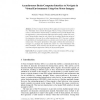Free Online Productivity Tools
i2Speak
i2Symbol
i2OCR
iTex2Img
iWeb2Print
iWeb2Shot
i2Type
iPdf2Split
iPdf2Merge
i2Bopomofo
i2Arabic
i2Style
i2Image
i2PDF
iLatex2Rtf
Sci2ools
IWANN
2009
Springer
2009
Springer
Asynchronous Brain-Computer Interface to Navigate in Virtual Environments Using One Motor Imagery
A Brain-Computer Interface (BCI) application focused on the control of a wheelchair must consider the danger which a wrong command would involve in a real situation. Virtual reality is a suitable tool to provide subjects with the opportunity to train and test the application before using it under real conditions. Recent studies aimed at such control let the subject decide the timing of the interaction, those are the so-called asynchronous BCI. One way to reduce the probability of misclassification is to achieve control with only two different mental tasks. The system presented in this paper combines the mentioned advantages in a paradigm that enables the control of a virtual wheelchair with three commands: move forward, turn left and turn right. The results obtained over three subjects support the viability of the proposed system.
Artificial Intelligence | Brain-computer Interface | IWANN 2009 | So-called Asynchronous Bci | Wrong Command |
| Added | 27 May 2010 |
| Updated | 27 May 2010 |
| Type | Conference |
| Year | 2009 |
| Where | IWANN |
| Authors | Francisco Velasco-Álvarez, Ricardo Ron-Angevin |
Comments (0)

